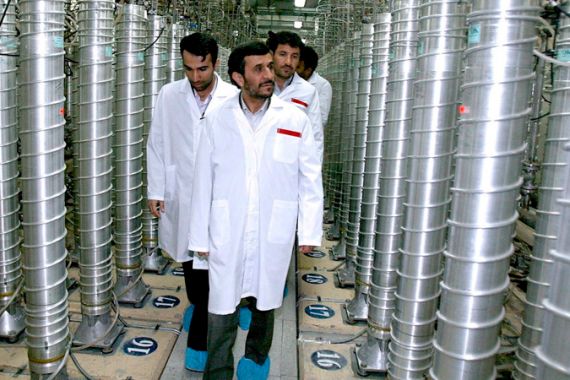Iran tests ‘homegrown’ nuclear fuel rods
Locally made rods reportedly inserted into core of research reactor, as navy test-fires radar-evading missiles in drill.

Iran has successfully produced and tested fuel rods for use in its nuclear power plants, state television reported, as the country’s military fired surface-to-air missiles during war games in the Strait of Hormuz.
Meanwhile, Iran’s currency, the rial, slipped to a record low on Sunday, the day after the US imposed extra sanctions targeting the Islamic Republic’s central bank and financial sector.
The new nuclear rods were made with uranium ore deposits mined in Iran and have been inserted into the core of Tehran’s research nuclear reactor, the Iranian Atomic Energy Organisation said on Sunday.
Nuclear fuel rods contain small pellets of fuel, usually low-enriched uranium, patterned to give out heat produced by nuclear reaction without melting down.
Iran said last month that it planned to insert domestically produced uranium fuel into the Tehran research reactor, which produces isotopes for medical purposes and currently runs on a nearly depleted stock of nuclear plates bought from Argentina in 1993.
“This great achievement will perplex the West, because the Western countries had counted on a possible failure of Iran to produce nuclear fuel plates,” the Tehran Times newspaper said.
The Tehran reactor requires uranium enriched to 20 per cent, a far higher level than that needed for Iran’s Russian-built nuclear power plant in Bushehr, on the Gulf coast, which uses Russian fuel that is returned when spent.
The atomic energy organisation did not specify the level of enrichment of the trial fuel rod but Iran’s programme to enrich uranium to the higher level has been at the centre of growing Western concerns about the goals of its nuclear programme.
John Large, an independent nuclear consultant, told Al Jazeera the reported developments would mean that Iran “can now produce key radioactive elements” and has moved “steps forward on the nuclear path”.
Western governments have expressed fears that Iran’s real aim is to develop a capability to enrich uranium to the 90 per cent level necessary for a nuclear bomb, an ambition Tehran strongly denies.
Uranium enriched to 20 percent level is normally manufactured into plate, not rod, form for use as fuel. But Western governments nations have expressed scepticism that Iran has the technology to produce plates.
Missile tests
Earlier on Sunday, Iran said it has successfully test fired a medium-range surface-to-air missile during navy war games taking place near the strategic Strait of Hormuz.
“This medium-range surface-to-air missile is equipped with the latest technology to combat radar-evading targets and intelligent systems which try to disrupt missile navigation,” Mahmoud Mousavi, navy spokesman, was quoted as saying by the official IRNA news agency.
He said it was the first time Iran had tested the missile, named Mehrab, which was “domestically designed and built”. Other details about the missile, including the exact distance it can fly, were not given.
Mousavi also said that the 10 days of war games were to end on Monday with all ships and submarines exercising a new tactic to practise the closure of the strait “if Iran’s navy so chooses”.
The missile’s launch and the war games are meant to show Iran’s military capabilities at a time that the US and other Western nations are increasing pressure over Tehran’s nuclear programme.
Al Jazeera’s John Terrett, reporting from Washington, said: “Hawks [in the US] are very keen to see some kind of military action or threat after the test-firing.”
The fact that tests are taking place near the Strait of Hormuz has focused attention on Iran’s threats in recent days that it could close the narrow channel, a strategic oil route at the entrance to the Gulf, if more oil sanctions are imposed.
Sanctions law
In a move that could intensify a brewing Gulf showdown, US President Barack Obama on Saturday signed into law tough new sanctions targeting Iran’s central bank and financial sector.
On Sunday, the state news agency IRNA and an Iranian website tracking the currency said the Iranian currency’s street value at money changers’ had slid to around 16,000 to the dollar. That represented a huge difference with the official central bank rate of 11,179 rials to the dollar.
But Iran has dismissed the new financial sanctions, which aim to reduce Tehran’s oil revenues but give the US president powers to waive penalties as required.
Mohammad Nahavandian, the head of Iran’s Chamber of Commerce, rejected the move as “unjustifiable”, saying on Sunday that such sanctions would have reciprocal consequences.
“The Iranian nation and those involved in trade and economic activities will find other alternatives,” Nahavandian said.
The US and the EU have already pushed four rounds of sanctions through the UN over Iran’s nuclear programme and imposed unilateral measures that have deterred Western investment in Iran’s oil sector, making it harder to move money in and out of the country.
Imposing sanctions on the central bank would make it more difficult for Iran to receive payments for exports – particularly oil, a vital source of hard currency for the world’s fifth-biggest crude exporter.
Iranian officials insist that foreign sanctions have had no impact on the country’s economy.
“The sanctions have raised the cost of trade and economic transactions but it has not managed to change Iran’s political behaviour,” Nahavandian said.